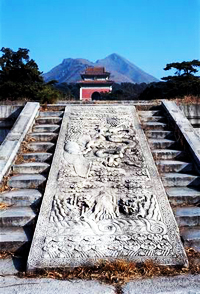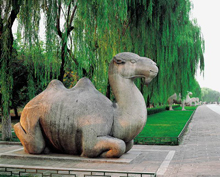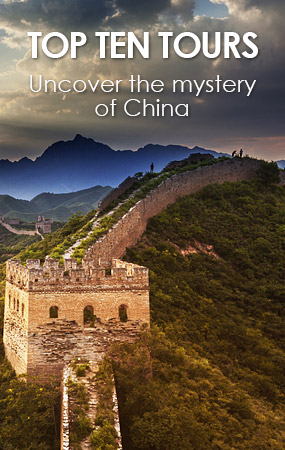Architecture of Ming Tombs
In the early 14th century China the Yuan dynasty ruled China. Being of Mongol heritage, these foreign rulers never enjoyed legitimacy in the eyes of the Confucian elite.  By 1356 their dynasty was in disarray, seething with rebellion from a combination of natural and administrative calamities. By 1359 they had lost the important southern city of Nanjing to an upstart rebel leader named Zhu Yuanzhang, a young man of peasant origins. In a series of swift campaigns, the rebels overran most of southern China and pressed at the gates of Beijing. By 1368 it too had fallen, and the rebel leader declared the founding of a new Chinese dynasty: the Ming, which in Chinese means "bright".
By 1356 their dynasty was in disarray, seething with rebellion from a combination of natural and administrative calamities. By 1359 they had lost the important southern city of Nanjing to an upstart rebel leader named Zhu Yuanzhang, a young man of peasant origins. In a series of swift campaigns, the rebels overran most of southern China and pressed at the gates of Beijing. By 1368 it too had fallen, and the rebel leader declared the founding of a new Chinese dynasty: the Ming, which in Chinese means "bright".
The Ming enjoyed the advantages of native Chinese origin. The dynastic founder, Zhu Yuanzhang, adopted the reign name Hongwu and set about creating an efficient (if ruthless) administration that eventually incorporated all the modern provinces except Xinjiang.When he died in 1398 power passed to his grandson and successor, Zhu Jianwen (r. 1399-1402).
Like his grandfather, Zhu Jianwen ruled from Nanjing, a prosperous trading city and capital of the Ming empire. As a southerner descended from southerners, Zhu Jianwen probably felt comfortable in Nanjing as he assumed power at age 21. However, ruling from the south was inherently problematic. Although the military might of the Ming was concentrated along the northern frontier, the government was based  in the south. Because of the difficulty communicating over long distances, the government reluctantly gave the northern generals the authority to act independently of Nanjing. One of these generals, Zhu Di, was a direct descendent of Zhu Yuanzhang, the Ming founder. He was an ambitious man well aware of his royal ancestry.Taking advantage of his army's distance from Nanjing, he created an independent power base in the north and stirred up a rebel army. When the army was ready, he rose up against his nephew the Emperor and plunged China into a civil war between north and south that lasted for five years.
in the south. Because of the difficulty communicating over long distances, the government reluctantly gave the northern generals the authority to act independently of Nanjing. One of these generals, Zhu Di, was a direct descendent of Zhu Yuanzhang, the Ming founder. He was an ambitious man well aware of his royal ancestry.Taking advantage of his army's distance from Nanjing, he created an independent power base in the north and stirred up a rebel army. When the army was ready, he rose up against his nephew the Emperor and plunged China into a civil war between north and south that lasted for five years.
Zhu Di marched south with his armies and captured Nanjing, unseating his rival. Instead of declaring Nanjing the capital, he decided to move north where he could directly oversee the frontier armies, thereby preventing the same sort of insurrection that had enabled his rise to power. Soon his advisers located an auspicious site in the northern plains, which would one day become Beijing. Up to a million laborers worked to create the new capital, finishing it in five years.
Zhu Di was very conscious of his own mortality, and greatly concerned himself with finding a proper and auspicious burial site. His father, the first Emperor, had set up an imperial tomb in Nanjing, but Zhu Di felt it was better if he and his successors were to be buried near the new capital.The decision to move to a new tomb site was not taken lightly.The Emperor consulted masters of feng-shui, the Chinese discipline of geomancy, in search of a flat area in the midst of a ring of mountains.An ideal site would have rivers flowing in the south and ample sunlight from that direction.There was much wrangling over the proper place, but the Emperor finally decided on a spot about forty kilometers northwest of Beijing. Here, in the shadow of a mountain called "Heavenly Longevity," he and his 12 successors were buried in imperial splendor.

